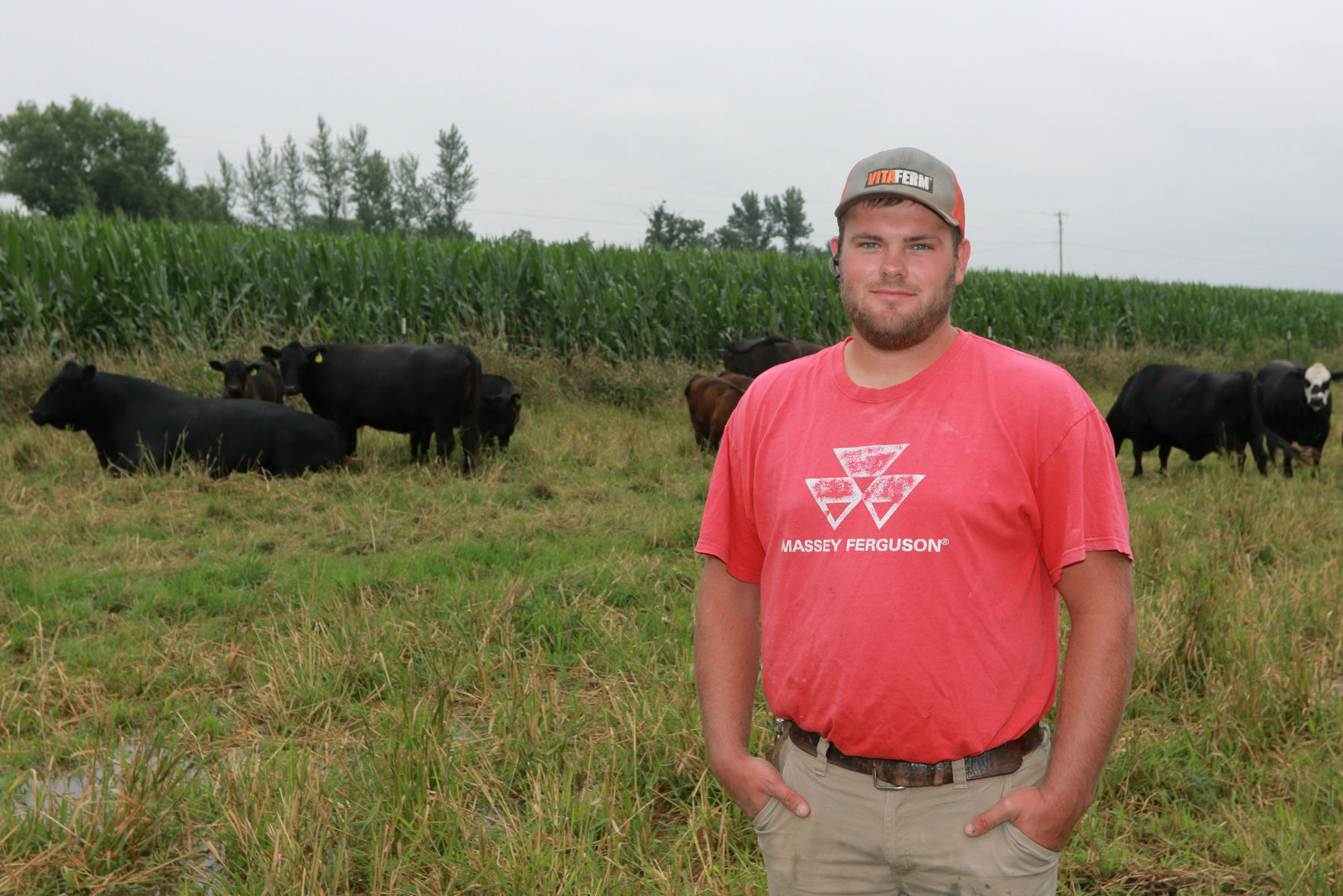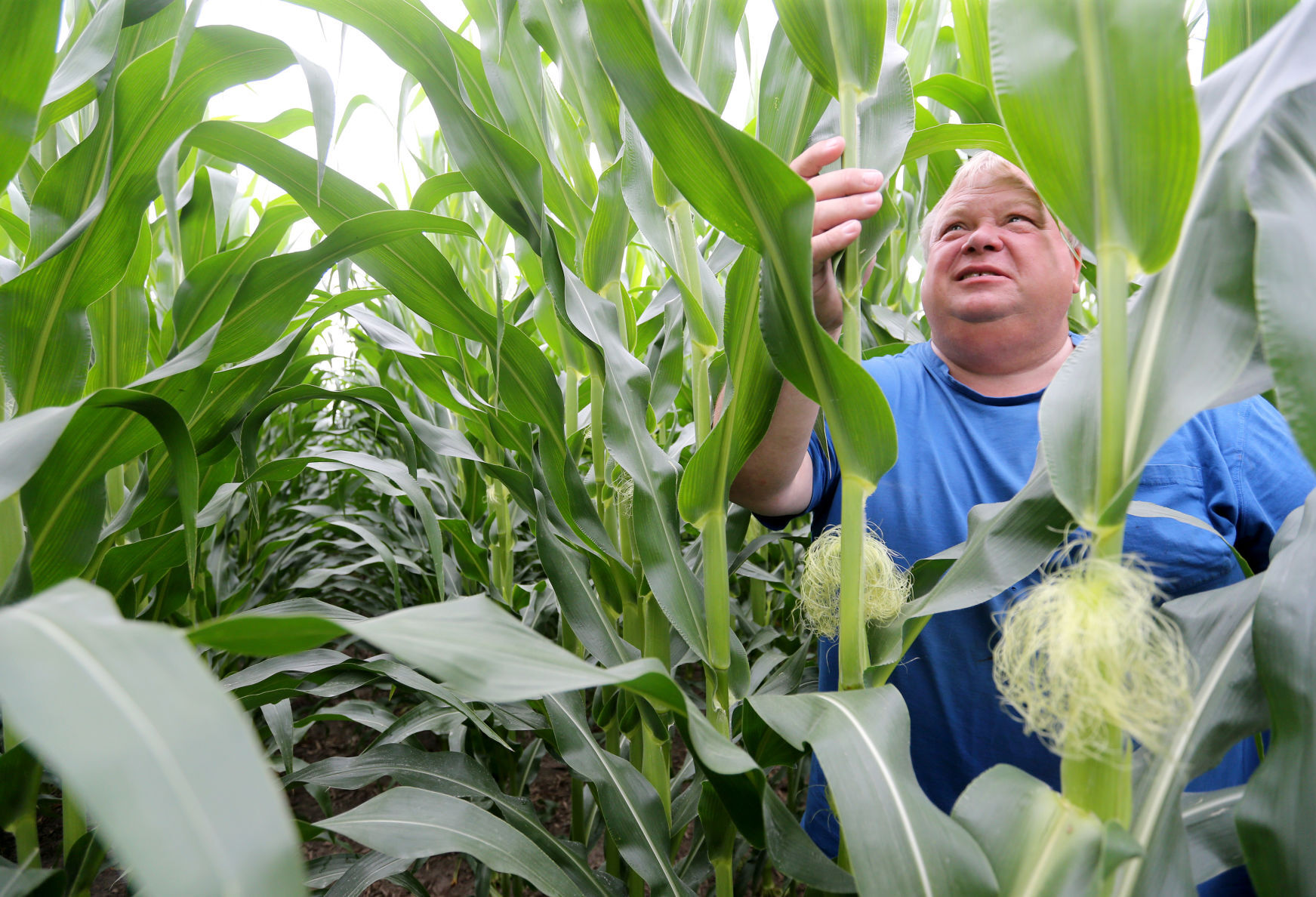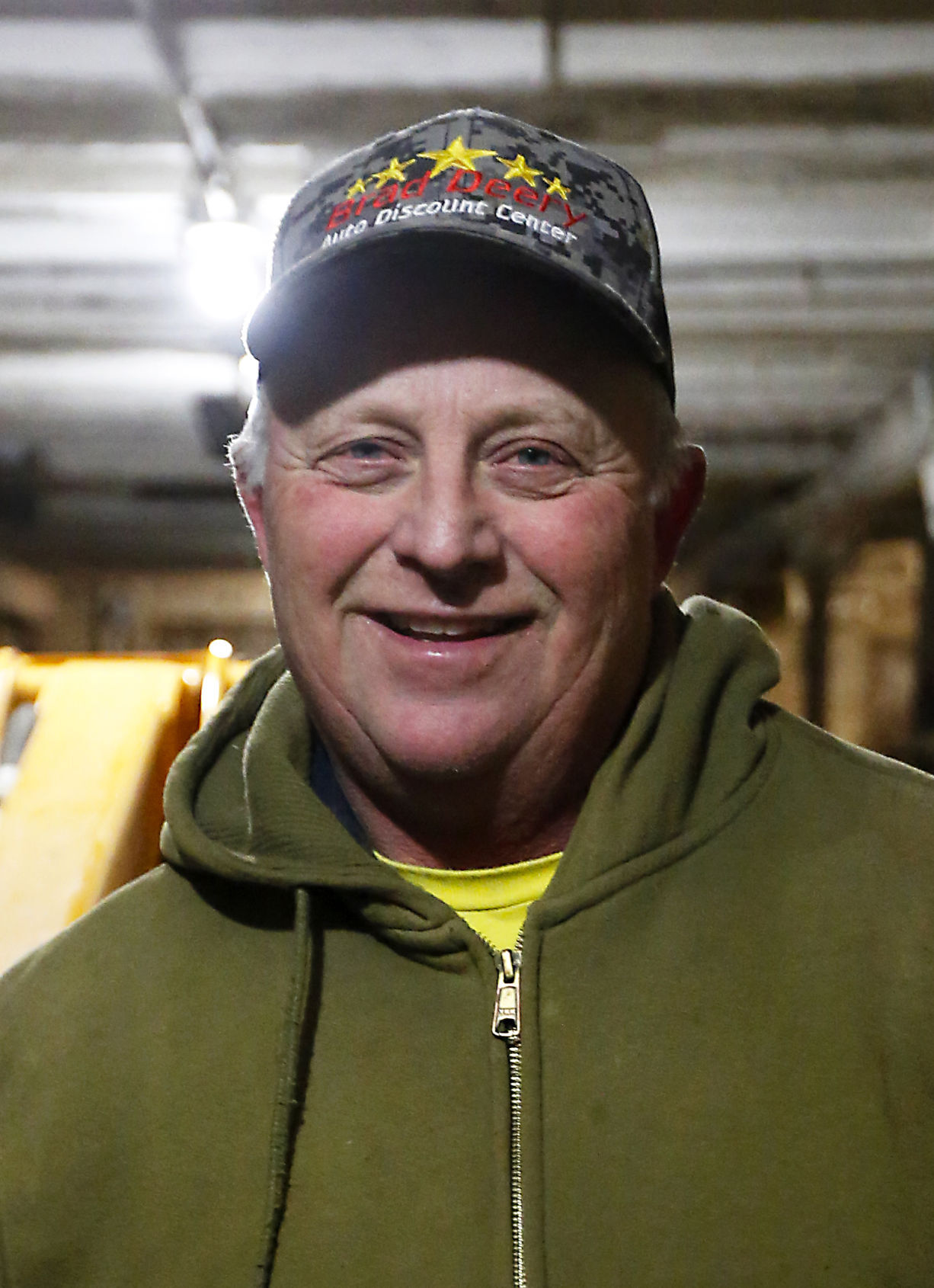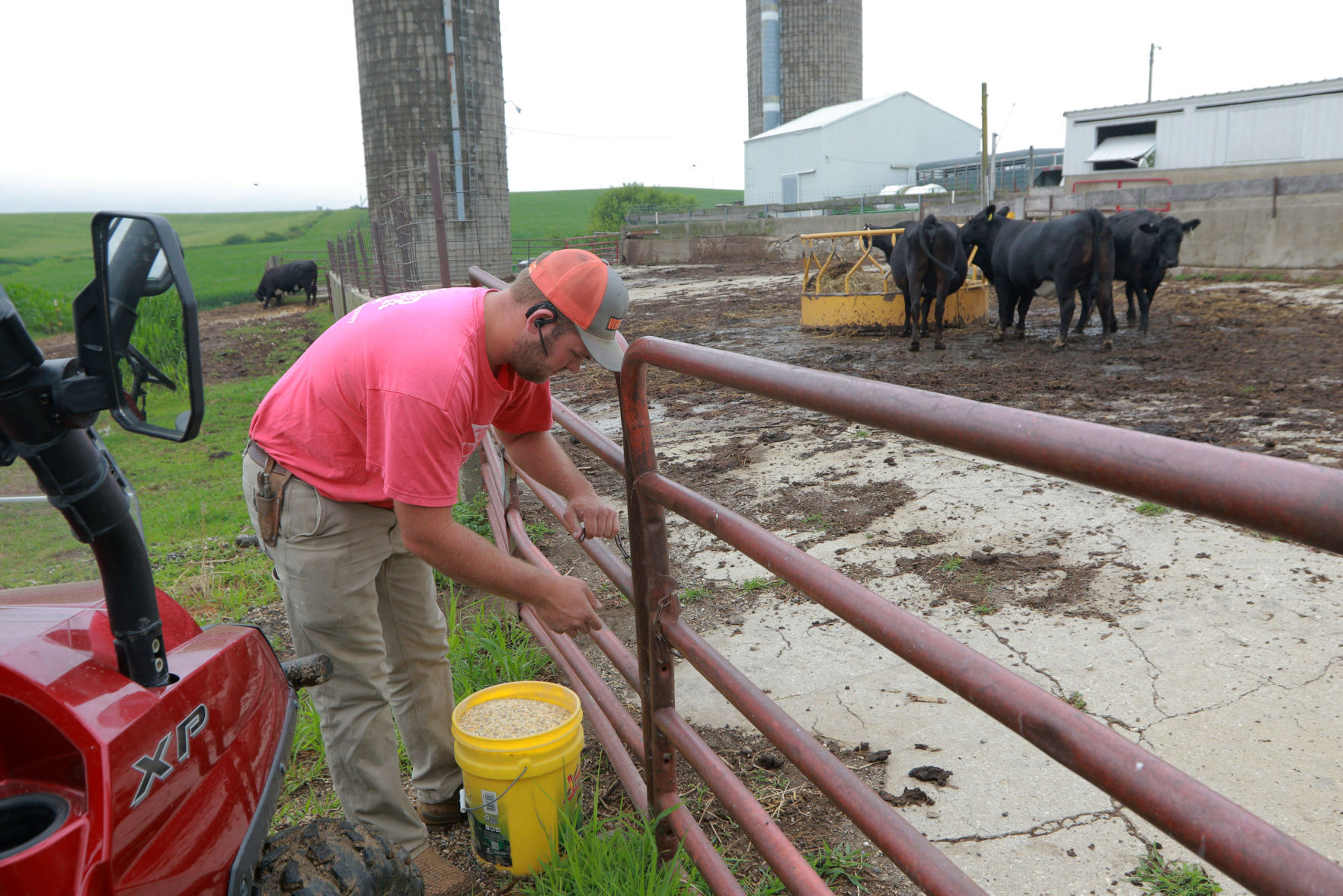NEW VIENNA, Iowa — After wrapping up a long shift at his day job, Dylan Hoefler knows there is often more work to be done.
Hoefler, 24, lives in New Vienna and works in underground utility construction. His evenings and weekends, however, are often spent pitching in at his family’s farm, located just east of town.
“I will go out and check on the cows, feed them, give them hay if they need it,” he said. “I work more during the calving season. You are checking them two or three times a day. When you don’t have that many cows, you have to make sure you are taking good care of them.”
He emphasized that the extra work isn’t a burden.
Instead, it gives him a sense of peace and perspective — and brings him back to the setting in which he is most comfortable.
“It’s where I am happy,” he said. “It’s something that is hard to describe to someone who has never done it. I love working with the animals. … The views on the farm are spectacular. There’s never a moment on the farm when I’m unhappy.”
CONFRONTING CHALLENGES
Hoefler ultimately strives to be a full-time farmer, but he realizes that industry trends make that easier said than done.
The number of U.S. farms peaked at 6.8 million in 1935. That figure fell sharply in the 1970s and has continued a steady decline ever since. The most recent U.S Department of Agriculture survey revealed there were 2.02 million U.S. farms in 2020, down nearly 200,000 since 2007.
The remaining operations find it increasingly tough to turn a profit.
Net farm income dropped nearly 50% from 2013 to 2018, according to the USDA. Income crept up by 3% in 2019 and then grew an additional 27% in 2020. But ag experts say that growth is misleading.
Government payments were the deciding factor in each of the past two years, with trade bailouts inflating the figure in 2019 and COVID-19 relief programs beefing up the figures last year. Advocacy group FarmAid noted that government payments accounted for 36% of farmers’ net income in 2020, the highest such percentage since 2001 and the eighth-highest percentage since the Great Depression.
Experienced farmers admit the economic landscape shifted dramatically in recent decades, with input costs soaring and commodity prices remaining stagnant.
Jeff Pape, who grows multiple crops just outside of Dyersville, represents the latest generation of a family that has farmed in the region for about 170 years.
At times, he feels he has more in common with previous generations than he would like.
“During the previous two or three years, we had seen corn at just below $3 (per acre),” Pape recalled. “That is equal to what my dad was getting 40 years ago.”
Pape concedes that this year has been better, with grain selling at prices that allow most growers to turn a profit. But he said this is the exception, not the rule, and the good times aren’t built to last.
“The rallies have been few and far between, and they usually don’t last long,” he said. “And what usually happens when these prices go up? You also see land prices go up. You see inputs and rents go up. And those things don’t drop as fast as they rise.”
CARRYING ON TRADITION
Since the day he was born, the family farm has been a central part of Hoefler’s life. But he is acutely aware that things almost worked out very differently.
Hoefler said his parents purchased the farm in 1990, seven years prior to his birth. He credits his parents, Craig and Karen, for “sticking it out” in those initial years, noting that they contemplated selling the farm after experiencing early financial struggles.
Their grit inspires him to follow a similar path.
“There is always that pressure to keep it going,” he said. “You drive past century farms and look forward to getting there with your own family’s farm.”
Despite all that has changed in the industry, family farms remain the bedrock of American agriculture.
Family farms accounted for nearly 98% of U.S. farms in 2019, according to USDA data. The agency defines family farms as operations in which the majority of the business is owned by the operator and individuals related to the operator.
The figures also show that larger farms wield outsized control of the industry.
Small farms, defined as those with gross cash farm income of less than $350,000 annually, represent 90% of U.S. operations but account for only 21.5% of production. Large-scale family operators, or those with annual income exceeding $1 million, make up just 3% of farms but account for 44% of production.
These realities weigh on young farmers.
At the age of 24, Hoefler is already acutely aware that modern ag is about scale.
He said he only feels confident in pursuing agriculture if he can add to the size of his current family operation, which would require additional cows, additional equipment and, most notably, additional acreage.
Working in another industry gives him the best chance of building up the necessary funds to do so.
“At some point, I would absolutely love to (be a full-time farmer),” he said. “But right now, I have to go where the money is at.”
If land is the key to a career in agriculture, getting one’s foot in the door is exceedingly difficult.
Chuck Schwager, a broker and owner of East Iowa Real Estate in Maquoketa, has spent decades selling farmland in the tri-state area.
He emphasized that there is a shortage of available farmland, which only drives up prices. Land values in southern Iowa have fallen as of late after an extended period of severe drought, but the northeast portion of the Hawkeye State remains prime real estate.
With limited availability and steep prices, aspiring farmers and other small-scale operators can find it hard to compete.
“There are some young farmers looking for land,” Schwager said. “But it can be difficult (for that demographic). Seventy-five percent of land sales go to some type of farmer or operation with a lot of equity. There are a lot of farmers who have been in the industry a long time, and they realize that they need to be purchasing land and adding to their existing operation.”
CHANGING TIMES
After four decades at the helm of his farm, Jack Smith reflects proudly on the path he took in life.
Smith operates a farm in Bankston and represents the fifth generation of his family to make a living in agriculture.
“I had other options coming out of high school. I had the opportunity to go to college,” he said. “But I can say I have zero regrets about staying on the farm.”
Smith grows soybeans and hay, but the “main enterprise” is beef cattle.
He acknowledged there is a significant discrepancy between the agriculture industry he first encountered and now.
“Back then, you could raise a family on 160 or 200 acres,” he said. “Between now and then, it has become a very low-margin business. If you want to make a living farming, you have to increase your volume quite a bit.”
He said many of the farms surrounding his land still are run by the same families that operated them when he was growing up. But while the faces are familiar, the nature of the job has changed.
“These days, many families only operate their farms during the weekends and have other jobs during the week,” he said. “That wasn’t the case when I first started.”
Smith’s observations reflect broader agricultural trends.
A recent report by nonprofit organization The Conversation found that half of all U.S. farm families have at least one adult working an additional full-time job off of the farm, often primarily to get health insurance coverage.
One in two U.S. farm families reported that they are worried they would have to sell farm assets to pay health expenses, according to that same report.
Child care is also a major concern, the study noted. It goes on to state that women — the fastest-growing segment in the industry — are increasingly concerned about working in agriculture because of that very issue.
Pape, of Dyersville, understands where these concerned families are coming from.
“When you think about the cost of land and rent, for young farmers, that can eat away at whatever profit you make,” he said. “There is not enough left to raise a family. It can take a couple years of excellent (commodity) prices to catch up on bills.”
FINDING SOLUTIONS
Wisconsin Rep. Travis Tranel, R-Cuba City, knows the struggles of family farms all too well.
On one hand, he represents what he described as a “very rural” district. On the other, Tranel is a sixth-generation farmer carrying on a tradition ingrained in his family.
“I see it from both sides, which is a blessing and a curse,” he said.
Tranel said conversations about agriculture’s changing landscape are muddled by a common misperception that “big ag” is bad. On the contrary, he believes that large-scale agriculture has played a vital role in ensuring that Americans have access to bountiful and affordable food.
The reliability of the food supply in the U.S. has lulled many consumers to sleep, Tranel suggested. While most Americans say they support small-scale farms, their actions don’t back that up.
“I think 98% of the country has lost touch with what ag does and why it’s important,” he said. “Farmers have gotten so good and so efficient that people don’t stop to think about it. And they typically will look for what they can get with the cheapest dollar.”
Tranel believes the nation needs a “balanced portfolio” of farmers, including both the big operations and the small ones. But Tranel said that’s a tall task in the current climate.
He emphasized that farmers, generally speaking, are currently getting paid less for their products than what they spent to produce them. And for many, the only way to shift the formula is to invest more and create economies of scale.
Tranel believes there are some ways to level the playing field.
One way, he said, is to make it easier for small farmers to purchase land and more difficult for large-scale investors to do so.
Another possible solution involves paying all farming operations an elevated rate for the first “x amount” of purchased commodities they sell to the government, Tranel said. These higher prices would disproportionately benefit smaller operations, which would sell a higher percentage of their goods at this higher level compared to their larger counterparts.
Tranel isn’t the only legislator with a rich background in agriculture.
Rep. Lee Hein, R-Monticello, began farming during the agricultural crisis of the 1980s. He presided over a modestly sized, farrow-to-finish farm that also produced corn and soybeans.
Over the years, he has expanded the scope of the operation when he could. It now includes 1,000 acres of corn and soybeans and about 500 head of cattle.
Despite this growth, the farm’s standing relative to others has moved in the opposite direction. Hein said the farm was considered a large operation back in the ‘80s and is now, by industry standards, a small one.
“The landscape has changed dramatically in the last 25 to 30 years,” he said.
Hein also admitted that solutions are hard to identify. But he said the meatpacking industry stands out as a good place to focus.
He noted that a small group of massive meatpacking companies wield almost total control over the industry. These companies increasingly rake in large profits while beef producers sell their product at little or no profit.
These disparities have prompted concerns about possible collusion in the industry.
“I think increasing transparency is that market is a good first step,” Hein said.
Federal lawmakers also have pointed to the need for greater industry competition.
In the summer of 2020, U.S. Sen. Chuck Grassley addressed the issue on the Senate floor, arguing that consolidation in the beef industry has “threatened the livelihood” of many cattle producers throughout Iowa. He noted that four major producers dominate the market, limiting farmers’ ability to negotiate a fair price for their product.
Grassley at the time introduced a bill promoting competition in the industry, but it failed to gain the necessary traction.
STAYING ALIVE
Dubuque County farmer Wayne Kramer believes the complexities of today’s ag industry can be boiled down to a simplistic comparison.
To highlight the differences between large-scale and small-scale operations, he presented a hypothetical scenario with two farmers: The first is operating a beef cow operation with 100 cows and 100 acres of land; the other has 1,000 cows and 1,000 acres.
The small farmer must pay retail prices on all of the necessary inputs that keep his operation running. The larger operator, on the other hand, benefits from buying in bulk.
“The guy with 1,000 acres can buy semi loads of nitrogen. He can get a better discount on seed corn. He can purchase commodities at such a high volume that he is getting a better deal,” Kramer explained. “Because of that, the profit is a lot higher for the guy with a lot of land.”
Such realities widen the gulf between the haves and have-nots of the industry, creating a landscape where industry behemoths grow exponentially and newcomers remain stuck in neutral.
The plight of average farmers was thrust into the national spotlight this month when President Joe Biden issued an executive order promoting competition across multiple American industries
Federal officials have noted that the U.S. ag industry is heavily concentrated at the top, with just four companies controlling the world’s seeds. The Biden administration noted that the poultry and beef industries are similarly consolidated.
“This means they get less when they sell their produce and meat, even as prices rise at the grocery store,” Biden said in public remarks.
Among other things, the Biden administration proposed legislation that would make it easier for farmers and ranchers to sue companies for anti-competitive behavior. Such a change could give smaller producers some power in markets defined by bigger entities.
Many agree that something needs to change.
Pape emphasized that the existing combination of trends — stagnant costs and soaring expenses — cannot continue.
“The problem is that the cost of equipment and inputs has been consistently going up while prices (for commodities) are not,” he said. “A new combine today can cost you half a million dollars. A decent used machine can be $180,000 to $280,000.”
Some can bear that cost burden, and others can’t.
Buoyed by decades of earnings, longtime farmers are generally on more stable financial footing and, as a result, are capable of purchasing the needed land or equipment.
Even so, many are aware — and concerned — that aspiring farmers don’t have that luxury and could abandon the industry as a result.
“I am over the hump now. I am 65.” Kramer said. “If you are a young farmer trying to get started, and you have a huge debt load, you can go down fast. It can be difficult for them right now.”







